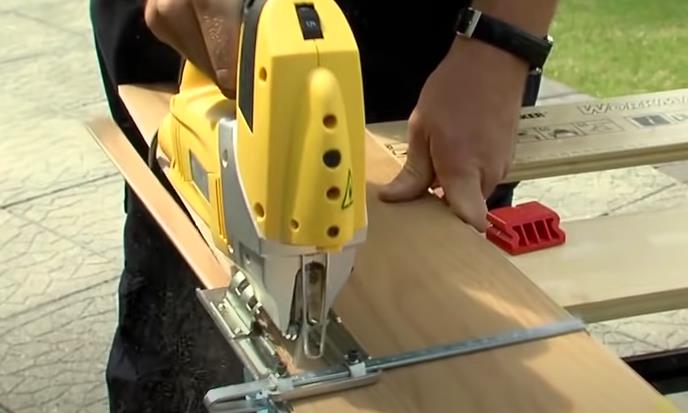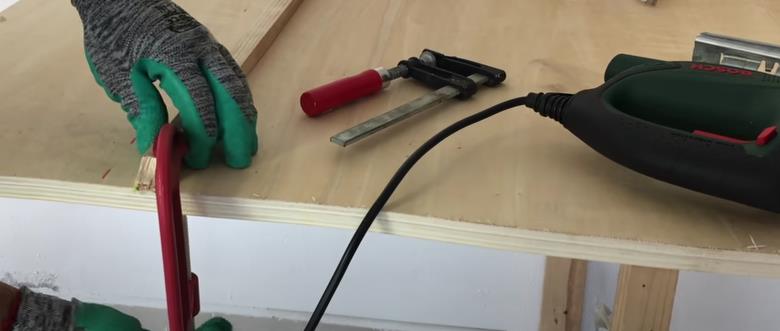A jigsaw is used to cut curved or irregular shapes in wood.
A jigsaw is a power tool that is used for various projects. But what is a jigsaw used for?
A jigsaw is a versatile tool that can be used for various tasks, such as cutting out shapes for plastic, making curved cuts in woodworking projects, or cutting metal pipes. It can also be used to make straight cuts in materials that are too thick to be cut with a hand saw.
The jigsaw has a small, thin blade mounted on a reciprocating arm. The arm is moved up and down by a motor, which causes the blade to cut through the material.
Remember, choosing the right blade for the material you are cutting and the right speed setting on the jigsaw are vital. Do not worry. Today I’m going to talk about jigsaws and how they’re used.
What Is A Jigsaw Used For

A jigsaw is a versatile power tool commonly used to cut wood, metal, plastic, and other materials. The jigsaw consists of a handle with an electric motor attached to it.
A jigsaw is a power saw that uses a reciprocating blade to cut curves and irregular shapes in wood. And the blade can be moved up and down. A guide plate holds the blade in place, which helps keep the cut straight.
Jigsaws are used for many woodworking projects, such as cutting intricate patterns, making curved cuts, and shaping molding.
Here look,s take details about what is a jigsaw used for.
In woodworking, a jigsaw is often used to make curved or irregular cuts in pieces of wood. The tool’s ability to make tight turns and follow patterns makes it ideal for cutting intricate shapes or designs.
Jigsaws are also commonly used in construction to cut out holes for electrical or plumbing fixtures or to make cuts in drywall or other building materials.
In metalworking, a jigsaw is used to cut out shapes or patterns in metal sheets or plates. The tool’s ability to make precise cuts makes it ideal for cutting out intricate designs or patterns in the metal.
Jigsaws are also used in the automotive and aerospace industries for cutting out parts or components from metal sheets.
Jigsaws are also commonly used in other industries, such as jewelry, ceramics, and other crafts.
The tool is designed to be easy to use and can be adjusted to make different types of cuts. It is also lightweight and portable, making it easy to take to different job sites.
A jigsaw typically has a very thin blade that can make precise, delicate cuts in wood without causing too much damage to the surrounding material.
They can also create smooth, curved cuts when shaping molding or other types of trim.
If you need to make complex cuts in wood, then a jigsaw is the perfect tool for the job. Its precision blade and ability to follow curved lines can handle just about any cutting challenge you throw at it.
So next time you start a new woodworking project, reach for your jigsaw and get ready to create some beautiful pieces.
How Do You Use a Jigsaw Step by Step?
Assuming you would like a step-by-step guide on how to use a jigsaw:
Read:
Read the manual that came with your jigsaw. This will ensure that you are using it correctly and safely. If you do not have the manual, look up the model online and read the digital version.
Select The Appropriate Blade:
Before you use a jigsaw, you need to make sure you have the right blade for the material you’ll be cutting. Jigsaw blades come in different types, such as wood, metal, or plastic, and it is essential to use the right one for the job. Make sure to check the blade compatibility with your jigsaw model.
Install The Blade:
Install the blade into your jigsaw, following the instructions in your manual or those that came with the blade itself. Make sure it is installed correctly and securely before proceeding.
Secure The Workpiece:
Set up your workpiece on a stable surface, such as a worktable or sawhorse. Make sure it is securely clamped in place to prevent movement while cutting. This will ensure that the cut is accurate and safe.
Adjust The Base Plate:
Adjust the jigsaw’s base plate to the desired angle, or use the built-in laser guide to ensure a straight cut. This will help you accurately guide the jigsaw along the cutting line and make a smooth, clean cut.
Start The Jigsaw:
Plug in the jigsaw and turn it on. Slowly lower the blade into the material, keeping your fingers and other body parts away from the blade.
Begin Cutting:
Begin cutting by applying steady pressure to the jigsaw’s handle and guiding the blade along the marked cutting line. Keep the jigsaw moving steadily to ensure a smooth, clean cut. If the cut is not straight, adjust the angle of the base plate or the pressure on the handle.
Slow Down Near The End:
As you near the end of the cut, slow down and reduce the pressure on the jigsaw. This will help prevent the blade from bending or breaking.
Turn Off The Jigsaw:
Once the cut is complete, please turn off the jigsaw and unplug it. Carefully remove the workpiece from the clamps and inspect the cut for any rough edges or burrs that may need to be sanded or filed down.
Clean And Maintain The Jigsaw:
Change the blade, clean the sawdust, debris, and oil the jigsaw, if necessary, before storing it properly. This will ensure the longevity of your jigsaw.
Safety tips: Always use proper personal protective equipment such as safety goggles, dust masks, and gloves when operating a jigsaw. Be aware of the cutting direction and keep your fingers away from the blade. Before using a jigsaw, you should always read the manual and follow the safety instructions given by the company that made it.
How To Use a Jigsaw With Safely

Jigsaws are an excellent tool for a variety of woodworking projects. They can cut intricate shapes and patterns and straight and curved lines. However, jigsaws can also be dangerous if they are not used properly.
A jigsaw can be used safely if you follow these tips:
- When using a jigsaw, wear safety goggles. By doing this, you will be able to protect your eyes from flying debris.
- To avoid inhaling sawdust, wear a dust mask.
- Ensure the area is well-ventilated to prevent fumes from the saw blade from overheating.
- Allow the saw to cut for you – never force the blade through the material. When the blade is forced, it may break or bind, causing severe injuries.
- Keeping your fingers away from the blade, guide the cut material with your other hand. Your hand should be treated immediately if it comes into contact with the blade. It is possible to require surgery later to correct invisible injuries such as crushed nerves or tendon damage.
What Are The Different Types Of Jigsaw Blades?

The teeth on a jigsaw blade are important for two reasons: they determine the type of material the blade can cut, and they affect the quality of the cut. There are three types of teeth on jigsaw blades:
- Standard teeth: Standard teeth are the most common type and are designed for cutting wood and wood-based materials.
- Fine teeth: Fine teeth are designed for cutting metal and plastic.
- Coarse teeth: coarse teeth are designed for cutting masonry and stone.
The number of teeth on a blade also affects the quality of the cut. A blade with more teeth will produce a smoother cut, while a blade with fewer teeth will be more aggressive and faster.
Now that you know the different types of jigsaw blades, here are some tips on when to use them:
- T-Shank blades have a T-shaped shank that fits into the jigsaw’s chuck, providing a secure grip and reducing the likelihood of the blade coming loose during use.
- U-Shank blades, which have a U-shaped shank that fits into the jigsaw’s chuck, are similar to T-shank blades.
- Clean Cut blades are designed for precise cuts in wood, plastic, and other materials.
- Fast Cut blades are designed for rough cuts in wood and other materials.
- Scroll blades are designed for intricate cuts in wood and other materials.
- Metal blades are designed for cutting metal.
- Wood/Metal blades are designed for cutting wood and metal.
- Progressor blades have a variable tooth pitch, allowing them to cut various materials.
- Demolition blades are designed for heavy-duty cutting and demolition work.
Now that you know the different types of jigsaw blades and when to use them, you’re ready to tackle your next project. Just be sure to select the correct blade for the material you’re working with, and you’ll be sure to get the best results.
Final Thought
A jigsaw is a handy tool for anyone who likes to remodel or rebuild projects around their house. As the name suggests, it consists of many pieces that are fitted together like a puzzle and can be used to cut wood, plastic, and other materials.
Jigsaws come in various sizes and shapes, so they can be tailored to fit your needs. A jigsaw is essential to make simple repairs or completely overhaul your home’s décor. It is a valuable tool for both home and professional use.
However, I hope you enjoyed my article about what is a jigsaw used for. With this knowledge, we know that you can make the most of your tools when using them for your projects. So what are you waiting for? Start looking for your next project today by visiting “What Is A Reciprocating Saw Used For.”
FAQ
What are the main parts of jigsaw tools?
The main parts of a jigsaw tool typically include the following:
1. Power cord or battery.
2. On/off switch.
3. Blade clamp.
4. Base plate.
5. Shoe plate.
6. Handle.
Some jigsaw tools may have additional features, such as a laser guide or a variable speed control.
But the blade itself is also an essential part of the jigsaw, as it is responsible for cutting through the material.
What are the different types of jigsaws?
There are several types of jigsaws, including corded, cordless, barrel-grip, top-handle, orbital, barrel-grip orbital, variable speed, and scroll jigsaws. Each type has its own unique features and intended use, such as heavy-duty cutting tasks, light-duty cutting tasks, cutting curves and decorative designs, and the ability to adjust the speed of the blade.

